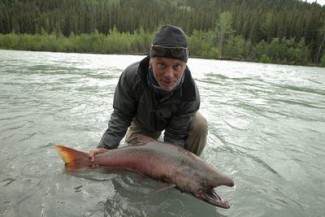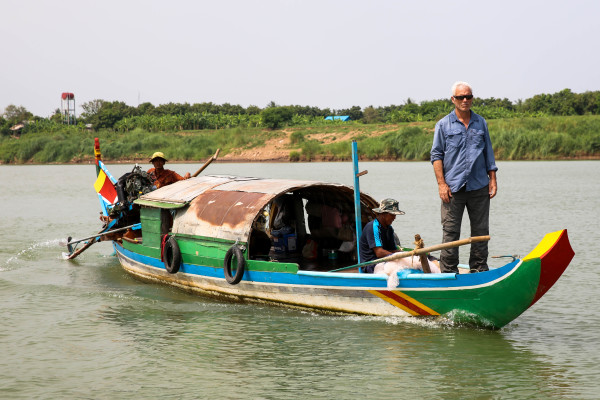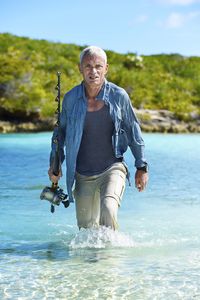INTERVIEW: Jeremy Wade returns for global adventures on ‘River Monsters’

Cool under pressure and dedication in his eyes, TV host Jeremy Wade is one of the most recognizable extreme anglers in the world. His #1-rated reality series, River Monsters, returns Sunday, April 5 for a seventh season of global adventures. This time he earns his frequent flyer miles, taking audiences to the depths of the Okavango Delta in Botswana, Fiji, Cambodia and seemingly everywhere in between.
It’s all in a day’s work for the fisherman.
“The last few years we have been starting to worry that we’re running out of material, but what tends to happen is that forces us to sort of think of it more, think of it harder,” Wade said recently during a phone interview. “And in some ways they’re getting more interesting, from my perspective anyway. And one of the things that we do is I spent a bit more time in the water. It’s something I have done a bit in the past, normally with just normal gear, free diving. Normally there’s not a lot of point because you’ve got no visibility, but if you pick your place and your time, you can see something in fresh water.”
On the new season, Wade heads into the waters of the Okavango, a beautiful delta in southern Africa’s Botswana. He was on the hunt for the tigerfish, which he described as a bit like salmon and scaled-up piranha. Swimming around Wade in the episode are plenty of hippos and crocodiles.
“Normally it wouldn’t be at all sensible to get in the water with crocodiles, but River Monsters is very much … about understanding what’s in the water and through that understanding keeping yourself safe,” he said. “The encounters I have with crocodiles very much sort of illustrate that. There is a way that you can get in the water and, as I did, actually lift up the tail of a crocodile. But it’s not something that you should do without knowing what you’re doing.”

The angler also heads into the cold waters of coastal Alaska. He seemed impressed by the “shark fins cutting the surface” with snow-covered mountains in the background. As with most episodes of River Monsters, what drove Wade and his crew to Alaska were local stories of anglers and their encounters with unusually large and sometimes fierce dwellers of the deep. In the Alaska episode, there were stories of fishermen disappearing, perhaps because of the sharks in the water.
“So something I sometimes do is use myself as human bait, so I jumped in,” he said. “And I lived to tell the tale, but we have some sort of dramatic moments during that.”
This season, which is the anchor of Animal Planet’s Sunday programming, also diverges from past episodes and heads back in time. Wade investigates prehistoric river monsters and travels with scientists to collect fossils.
“It’s about not just reconstructing what these creatures looked like but trying to visualize [them] alive in action and hunting,” he said. “We turned something that could have been quite a dry academic subject into something that’s actually very lively.”
When Wade’s team arrives in the local area to start shooting the series there’s a mix of skepticism and believability. With a background as a scientist, the TV host looks for evidence, but he understands that Amazon fishermen, for example, might not have cameras or mobile phones. The only evidence is eyewitness testimony, which sometimes can be exaggerated.
“But I have had experiences myself which people haven’t believed, and then I’ve managed to get a photograph,” he said. “Over the time that we have been [filming] River Monsters now I think only on two occasions has the initial story not led to us getting the creature in the end. But … exaggeration can be a factor, and sometimes the details are very vague. It’s not a first-hand account. It’s just something very vague that somebody’s heard. So there’s something down there. We don’t know what it is, but that’s the starting point. I’ll follow it through, get more information and ultimately it normally does lead to me bringing something up, which is pretty dramatic, and which a lot of people haven’t seen before.”

With so many adventures over so many years, the wow factor can be difficult to replicate.
“I think in the early days the obvious thing is it’s all about big fish,” he said. “But then, yes, I think we are now using a bit of lateral thinking. And, yeah, sometimes it’s something very small. … There’s a fish in the Amazon which burrows inside people, and that’s pretty creepy. We’ve featured small fish, which you still have to be careful with it. … One of the programs on the season actually, I went to Cambodia, and there are stories there about men having their genitals bitten. … So there’s something in there that’s not very big, but it’s very unpleasant. What on earth is it? How can people avoid this?”
Wade said if he wasn’t filming River Monsters he would probably still travel the world and take part in these extreme adventures. Before becoming a TV host, for example, he spent 20 years traveling the globe sometimes on three-month stints. He would often write about his experiences and try to sell the odd article or odd picture.
That life, though, is a long, long time ago. He’s now the host of a top-rated reality series and a much more focused angler.
“We all talk about genres, and people say it’s a fishing show,” he said. “I say it’s absolutely not a fishing show. That is one of the components, but that’s a means to an end. That’s just the way that I use to find out what’s down there in murky water that you can’t throw somebody in with a camera. I think it’s also very much the fact that it is all about a story. I think the programs are almost like mini feature films. We string everything together in the form of a story. The production values are very high. We don’t want it to be too slick because we are out in the middle of nowhere. It wants to be a little bit sort of rough and ready, and a bit energetic as well. But, yeah, we deliberately set out not just to appeal to people who fish, but to try and make it appeal to everybody.”
With his “geographical spread” quite impressive, there may be no more places or rivers left on the bucket list. But somehow it seems like the next adventure will always be on the horizon, either in new, unexplored places or revisiting old jaunts.
“Unlike normal fishing shows where it’s here’s a fish, here’s another fish, here’s another fish a bit bigger than the last one, we just need one dramatic fish at the end, big enough or interesting enough to make the program,” he said. “And, for me, very often just working out how to catch the fish is quite a puzzle, but then when I catch the fish I’m often of the opinion then I’ve cracked the puzzle. I know how this fish behaves. There’s a bigger one with my name on it. Just give me a bit more time, and I’ll get a bigger one. At that point the director has to sort of step in and physically sort of wrestle me away from the water sometimes.”
By John Soltes / Publisher / John@HollywoodSoapbox.com

